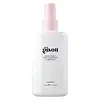What's inside
What's inside
 Key Ingredients
Key Ingredients

 Benefits
Benefits

 Concerns
Concerns

 Ingredients Side-by-side
Ingredients Side-by-side

Water
Skin ConditioningBehenamidopropyl Dimethylamine
EmulsifyingCetearyl Alcohol
EmollientLactic Acid
BufferingAdansonia Digitata Seed Oil
EmollientArgania Spinosa Kernel Oil
EmollientMel
EmollientSodium Benzoate
MaskingHydroxypropyltrimonium Honey
Panthenol
Skin ConditioningParfum
MaskingHydrolyzed Wheat Protein
Skin ConditioningHydrolyzed Adansonia Digitata Seed Extract
Benzyl Alcohol
PerfumingSaccharomyces/Magnesium Ferment
Sorbic Acid
PreservativeSaccharomyces/Iron Ferment
Skin ConditioningPotassium Sorbate
PreservativeSaccharomyces/Zinc Ferment
Skin ConditioningSaccharomyces/Copper Ferment
Skin ConditioningSaccharomyces/Silicon Ferment
Skin ConditioningCoumarin
PerfumingHexyl Cinnamal
PerfumingLimonene
PerfumingLinalool
PerfumingWater, Behenamidopropyl Dimethylamine, Cetearyl Alcohol, Lactic Acid, Adansonia Digitata Seed Oil, Argania Spinosa Kernel Oil, Mel, Sodium Benzoate, Hydroxypropyltrimonium Honey, Panthenol, Parfum, Hydrolyzed Wheat Protein, Hydrolyzed Adansonia Digitata Seed Extract, Benzyl Alcohol, Saccharomyces/Magnesium Ferment, Sorbic Acid, Saccharomyces/Iron Ferment, Potassium Sorbate, Saccharomyces/Zinc Ferment, Saccharomyces/Copper Ferment, Saccharomyces/Silicon Ferment, Coumarin, Hexyl Cinnamal, Limonene, Linalool
Water
Skin ConditioningAloe Barbadensis Leaf Juice
Skin ConditioningCetearyl Alcohol
EmollientC13-15 Alkane
SolventBehentrimonium Methosulfate
Butyrospermum Parkii Butter
Skin ConditioningGlycerin
HumectantIsopentyldiol
HumectantPolyquaternium-10
Simmondsia Chinensis Seed Oil
EmollientTheobroma Grandiflorum Seed Butter
Skin ConditioningQuaternium-91
Aloe Vera Callus Extract
AntioxidantCetrimonium Methosulfate
AntimicrobialHydrolyzed Vegetable Protein Pg-Propyl Silanetriol
Skin ConditioningAnanas Sativus Fruit Extract
Skin ConditioningSodium PCA
HumectantCetrimonium Chloride
AntimicrobialPanthenol
Skin ConditioningPhenethyl Alcohol
MaskingSodium Hyaluronate
HumectantProline
Skin ConditioningHydroxyproline
Skin ConditioningHydrolyzed Quinoa
Skin ConditioningPolyquaternium-37
Pisum Sativum Seed Extract
Skin ConditioningPropylene Glycol Dicaprylate/Dicaprate
Emollient1,2-Hexanediol
Skin ConditioningPPG-1 Trideceth-6
Skin ConditioningTocopheryl Acetate
AntioxidantCaprylhydroxamic Acid
Sodium Phytate
Water, Aloe Barbadensis Leaf Juice, Cetearyl Alcohol, C13-15 Alkane, Behentrimonium Methosulfate, Butyrospermum Parkii Butter, Glycerin, Isopentyldiol, Polyquaternium-10, Simmondsia Chinensis Seed Oil, Theobroma Grandiflorum Seed Butter, Quaternium-91, Aloe Vera Callus Extract, Cetrimonium Methosulfate, Hydrolyzed Vegetable Protein Pg-Propyl Silanetriol, Ananas Sativus Fruit Extract, Sodium PCA, Cetrimonium Chloride, Panthenol, Phenethyl Alcohol, Sodium Hyaluronate, Proline, Hydroxyproline, Hydrolyzed Quinoa, Polyquaternium-37, Pisum Sativum Seed Extract, Propylene Glycol Dicaprylate/Dicaprate, 1,2-Hexanediol, PPG-1 Trideceth-6, Tocopheryl Acetate, Caprylhydroxamic Acid, Sodium Phytate
Ingredients Explained
These ingredients are found in both products.
Ingredients higher up in an ingredient list are typically present in a larger amount.
Cetearyl alcohol is a mixture of two fatty alcohols: cetyl alcohol and stearyl alcohol. It is mainly used as an emulsifier. Emulsifiers help prevent the separation of oils and products. Due to its composition, it can also be used to thicken a product or help create foam.
Cetearyl alcohol is an emollient. Emollients help soothe and hydrate the skin by trapping moisture.
Studies show Cetearyl alcohol is non-toxic and non-irritating. The FDA allows products labeled "alcohol-free" to have fatty alcohols.
This ingredient is usually derived from plant oils such as palm, vegetable, or coconut oils. There is debate on whether this ingredient will cause acne.
Due to the fatty acid base, this ingredient may not be Malassezia folliculitis safe.
Learn more about Cetearyl AlcoholPanthenol is a common ingredient that helps hydrate and soothe the skin. It is found naturally in our skin and hair.
There are two forms of panthenol: D and L.
D-panthenol is also known as dexpanthenol. Most cosmetics use dexpanthenol or a mixture of D and L-panthenol.
Panthenol is famous due to its ability to go deeper into the skin's layers. Using this ingredient has numerous pros (and no cons):
Like hyaluronic acid, panthenol is a humectant. Humectants are able to bind and hold large amounts of water to keep skin hydrated.
This ingredient works well for wound healing. It works by increasing tissue in the wound and helps close open wounds.
Once oxidized, panthenol converts to pantothenic acid. Panthothenic acid is found in all living cells.
This ingredient is also referred to as pro-vitamin B5.
Learn more about PanthenolWater. It's the most common cosmetic ingredient of all. You'll usually see it at the top of ingredient lists, meaning that it makes up the largest part of the product.
So why is it so popular? Water most often acts as a solvent - this means that it helps dissolve other ingredients into the formulation.
You'll also recognize water as that liquid we all need to stay alive. If you see this, drink a glass of water. Stay hydrated!
Learn more about Water